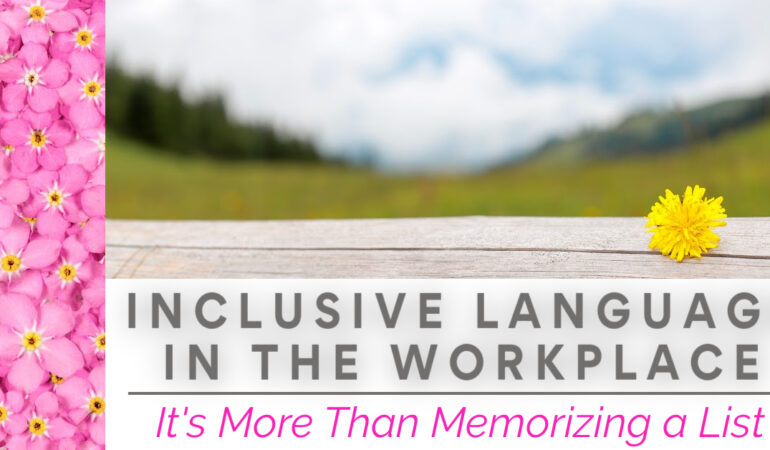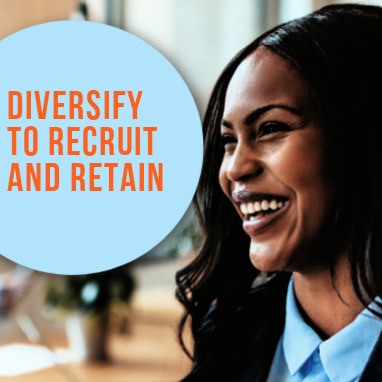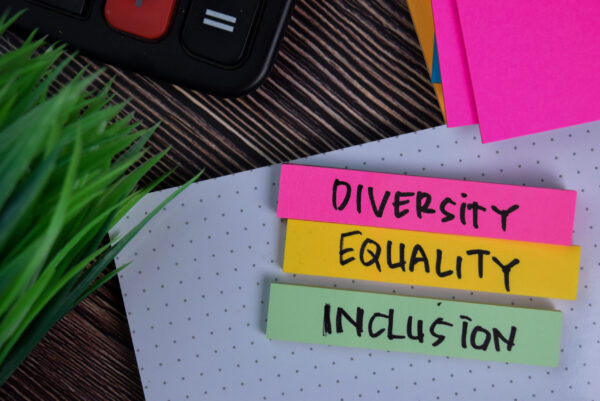It’s More Than Memorizing a List: Inclusive Language in the Workplace
By: Destyn Land
Part Three of Who’s Sitting at Your Table?
In my last article (which you can access here), I emphasized the importance of expanding our definition of diversity. We must begin to recognize how our social identities intersect with one another and go beyond what is merely visible. By becoming more aware of our own identities and the identities of others, we can equip ourselves to live more equitably and inclusively. One of the most effective ways we can promote DEI at work and in our everyday lives is by recognizing the power of language and adopting inclusive language. Often, the assumption is that inclusive language is just about memorizing lists of words and phrases that we should no longer use, but while these lists are useful starting points, true inclusivity begins by examining the intentions of our hearts.
Diversity, Equity, and Inclusion (DEI) is all about love. A genuine love for people should drive our desire to live in a world where everyone, regardless of their ethnicity, gender, socio-economic status, religion, ability, or body type, is well-represented in every industry. Love should drive our desire to want to work in a place where all employees receive equitable pay, discrimination is nonexistent, and where everyone can be their authentic selves without fear of judgment. The true measure of our commitment to DEI lies in our hearts’ intention. We must ask ourselves why we care about DEI—is it merely a matter of being compliance-ready or is it about co-creating a world where everyone can thrive?
The language and modes of communication adopted in our workplaces could have the power to determine who will succeed and who will not. Inclusive language, therefore, is essential.
Here are three ways to improve the use of inclusive language in the workplace.
- Avoid Using Acronyms
- Acronyms can be a significant challenge for new employees at a new workplace, as they need time to become familiar with the nuances of a new environment. Although acronyms tend to be common within tight-knit groups, it’s important to remember that not everyone will retain or understand the meaning of a given abbreviation. Although avoiding acronyms may seem like a minor suggestion, common usage of abbreviations can quickly create a sense of ‘in-group’ and ‘out-group’ dynamics, making new employees feel excluded from early on.
- Develop an Inclusive Language Policy
- Inclusive language is not just about eliminating acronyms – it involves deeper reflection on the language that may have roots in oppression and exclusionary histories (racism, anti-Blackness, homophobia, etc.). A true commitment to inclusion requires a shift in organizational culture to respect, empathy, and growth. Establishing an inclusive language policy enables organizations to align their values and mission with accountability, demonstrating to employees that they are committed to creating an equitable workplace. Those of us with marginalized identities have often witnessed organizations making empty promises – the mission statement sounds great, yet the actual practices fall short. In next month’s article, we will dive deeper into how policy can be a powerful tool for achieving a work culture that authentically reflects the organization’s values.
- Model the Way
- Whether we hold a position of leadership or not, others often pay close attention to our actions and words in the workplace. It is our individual responsibility to use language that does not discriminate against any group and to actively address and speak out against discriminatory language when we encounter it. Although Minnesota may be known for an aversion to confrontation, this should not stop us from taking a stand against exclusionary language. We can approach individuals who use non-inclusive language in a respectful one-on-one conversation to better understand their perspective and educate them on why their language was inappropriate and should be avoided in the future.
It is important to understand that no one is capable of always choosing the right words 100% of the time. Language is constantly evolving, and as we learn new information and gain new perspectives, we should reconsider our word choices. When we make mistakes (and we all will), it is crucial to remember that our intentions do not negate the impact of our words. Even if we did not mean to offend someone, that doesn’t take away the hurt or harm that our words have caused. In these situations, it is important to apologize, take responsibility for our actions, and educate ourselves to prevent future occurrences. Do not make the mistake of trying to defend yourself or convince others that you did not do something wrong. Instead, focus on recognizing and owning your mistake, learning from it, and working to avoid similar incidents in the future.















